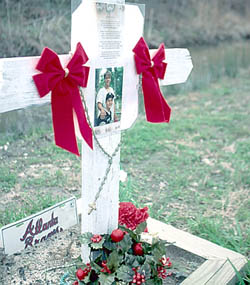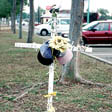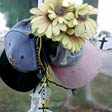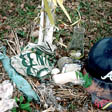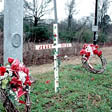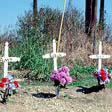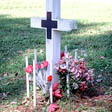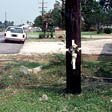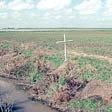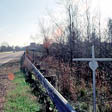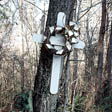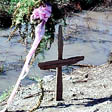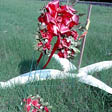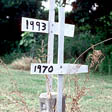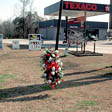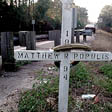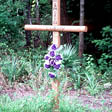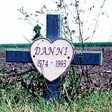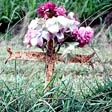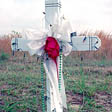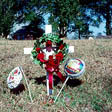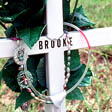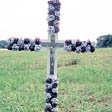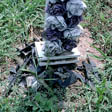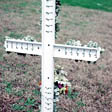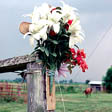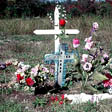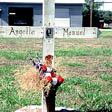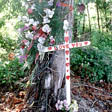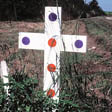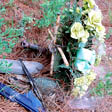Louisiana Roadside Memorials: Negotiating an Emerging Tradition
By Maida Owens
Roadside memorials have attracted attention from both researchers and the general public in recent years. These memorials evoke strong feelings since they remind us of our own mortality. While this tradition has a long history in many parts of the world, it has proliferated in recent years, spreading into non-Catholic and even non-Christian communities. In the last twenty years, these roadside memorials commemorating sites of violent death have spread into the American South, including Louisiana. But, not all traffic fatalities result in a memorial that is then maintained over time. I investigated factors determining whether a memorial is built and whether it remains, particularly focusing on the negotiation process.
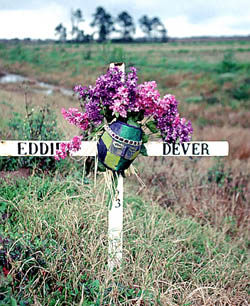
Providing an alternate location for graveside traditions and as a part of a complex of memorial practices, roadside memorials are most likely to be erected following the accidental death of a relative, especially a teen or a young adult, if the death site is close to the family home. Further, the memorial is likely to remain if the site does not involve private property, the family constructs the memorial in such a way that it does not create a safety hazard, and they regularly maintain it. Most roadside memorials in Louisiana have remarkably consistent physical traits. They are usually white wooden or metal Latin crosses with arms of unequal length, and those in Louisiana do not include any larger constructions such as those found in Mexico, Greece, and other areas with a much longer tradition. Technically, all of these memorials are placed illegally if they are in the highway right of way.
This memorialization transforms the death site into a positive place by transferring grave traditions and incorporating new ones. The proliferation has coincided with several other phenomena in American culture. In recent years spirituality and supernatural beliefs have become more acceptable and now more likely to be perceived as positive. For example, some narratives that previously featured ghosts now have angels. There has also been a depersonalization of some graveyards with adornments restricted or prohibited in many cases to ease maintenance of the space. This may not provide as effective a means for the family to grieve a death and as a result, they may turn their attention to the death site. At the same time, there is increased public awareness of drunk driving affecting driving safety. These phenomena may reinforce and assist in the proliferation of roadside memorials. Media coverage has supported spread of this tradition. All of these have resulted in the cross, a common Catholic symbol, becoming a more generalized symbol for death adopted by non-Catholics in this tradition of erecting a memorial at the place of death.
Examining the circumstances surrounding the erection and maintenance of the Louisiana memorials reveals new information. In these new locales, no established protocol exists for the family to follow, requiring negotiation to determine how they will proceed. For each memorial, families and friends must negotiate among themselves, with bureaucrats, and, at times, other community members for a memorial to remain in place. There are two phases of negotiation. The first is among family and friends and is part of the private grieving process. For each death, they must negotiate to determine whether they will place a memorial at the death site and what it will consist of. The second phase is between the private world of the grieving and the public: The deceased’s family and friends must negotiate with the landowner or the agency responsible for the highway right of way. At this point, they are, in effect, negotiating their private grief with public issues.
Over a four-year period between November 1994 and October 1998, I gathered information about 149 memorial sites in Louisiana, 139 of which included crosses. During this time, I personally experienced a family member's death in a traffic accident. The data below concentrates on the 93 sites with crosses for which I have photographs. I traveled most of the major highways and interstates and many back roads-some areas more intensively than others - but all quadrants of the state were covered. In addition to photographing the crosses and the surrounding area, I maintained written records describing the placement and adornment of the crosses. I also noted death circumstances obtained from the memorial or secondary sources. I also maintained a map indicating all roads traveled during the research period. A literature search revealed existing documentation of memorials elsewhere. The Internet listserv, Folklore-L and personal communication provided anecdotes on geographical distribution, and finally, a newspaper search revealed patterns in the media.
During this time, I investigated 93 memorial sites, which involved parking, getting out of the car, experiencing each space, noting details, and photographing the site. Through this repetitive process and having a personal experience with unexpected death, I came to realize that several factors determine whether a memorial will be erected and then maintained. First, I concluded that a cross is likely to be placed and maintained only if the death occurred in the general vicinity of the family's home especially if the grieving family or friends pass the site periodically. All the stories collected about crosses that continue to be maintained reveal that the family lives in relatively close proximity. Maintaining a cross provides a means for the grieving family to cope with their loss, especially if they have to pass the death site on a regular basis.
The second determining factor is the age of the deceased. Families are most likely to place a memorial for a teenager or young adult. Of the 28 crosses for which I know the deceased's age, 24 were between the ages of 15 and 25—deaths considered before their time. Putting up a cross may be a way of coping with the extreme grief of the death of one's child or classmate. Perhaps the parent is more likely than other relations or friends to maintain a cross or memorial, but classmates have participated in constructing, erecting, or decorating several crosses.
With the third factor, negotiation moves from among the family and friends to the public sphere. The third factor is the site of the death which most closely determines whether a memorial will remain once placed. A memorial is only likely to remain if it is placed in a space perceived to be what I refer to as “neutral”-spaces not involving inhabited private property. This is supported by narratives about the crosses in addition to the fact that of the 139 sites, only 17 appear directly in front of homes, churches, or businesses. All others appear in neutral spaces: public highway medians, urban intersections, in front of vacant land, planted fields, pastures, forested land, parks, and riverbanks.
In Louisiana, memorials can be found in rural, suburban, and urban settings. Nonetheless, the deciding factor is still whether the space is neutral. Numerically, they, most often, appear along roads in rural settings, but 17 of the 139 cross sites identified are in urban and suburban locales, and 18 are in small towns. The relatively smaller amount of road frontage considered neutral in highly-populated areas decreases the likelihood of urban memorials, and the proliferation of roads in urban areas make their appearance more difficult to identify.
Some memorials have a short life span and consist of only floral arrangements and mementos.
A fourth factor is whether the memorial's construction techniques and placement meet highway safety standards so that the memorial does not cause another death. If construction does not meet the approval of those in charge of the highway right of way or, occasionally, does not meet the approval of community members, authorities will remove the memorial. The crosses found in Louisiana vary according to materials, condition, adornment, and number of crosses at each site, but with few exceptions, generally do not create a safety hazard. Construction methods and materials range from simple, wood slats nailed together to more finely crafted wood and metal structures.
The most common form is a relatively simple wood cross approximately 24 to 36 inches tall, but many variations exist. The wood crosses can be made from driftwood, wood slats, two-by-fours, and treated lumber. They employ varied construction methods, including nailed, screwed, and fitted joints with chamfered edges. The metal crosses include welded rebar, angle iron, iron pipe, or more finely constructed pieces including three small French-style crosses. Some of the more substantial iron crosses use breakaway construction so that the bolts connecting the cross to a base will break first, minimizing damage to a vehicle.
A fifth factor is whether the family and friends maintain the memorial. At least 71 sites are in especially good condition and evidently maintained, while only seven are in poor condition with overgrown grass, rusted metal, and faded adornments. The relatively few in poor condition are likely due to road maintenance crews removing any that appear to not be maintained.
One sign that the site is maintained is changes in the decorations. Some crosses display elaborate decorations changed on the death anniversary and holidays.
Some adornments are typical of many grave traditions: flowers which may be plastic, silk, fresh, or wooden; vases; ribbons; bows; wreaths; Catholic items such as rosaries, scapulas, crucifixes, and images of Jesus; statues of angels; photographs of the deceased; and other presumably personal mementos. These include Mardi Gras beads, necklaces, vanity license plate, model car, shot glass, cigarette lighter, and rebel flag. Floral sprays on tripod stands are frequently placed beside the cross or occasionally on a nearby tree.
Decorations not typical of graves include red and blue reflectors, reflective letters, and white reflective paint. Three crosses have auto parts arranged at the base: windshield wiper, dealership nameplate, and parts of the front grill.
In summary, the evidence overwhelmingly shows that roadside memorials provide an alternate location for graveside traditions and are most likely to be erected following the accidental death of a relative, especially a teen or young adult, if the death site is close to the family home. Further, the memorial is likely to remain if the site does not involve private property, the family constructs the memorial so as not to create a safety hazard, and they regularly maintain it. At the same time, there is increased public awareness of drunk driving affecting driving safety. These phenomena reinforce and assist in the proliferation of roadside memorials into new communities without an established tradition. Each family must negotiate their own protocol in their efforts to give the death site a sense of place, to make sense of something that doesn't make sense, an untimely, violent death.


